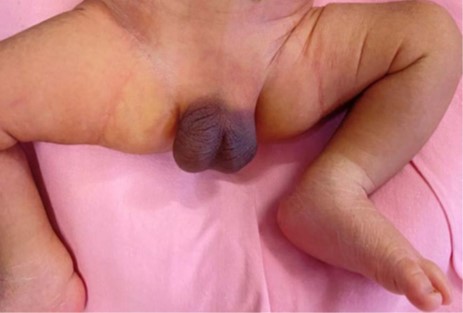Environ 100 cas décrits. Incidence estimée à 1/30.106 naissances.Absence de phallus. Peut être associée à un syndrome VACTERL ou une séquence malformative du septum urogénital (malformation anorectale et des organes génitaux externes, anomalies vertébrales). On utilise la classification de Skoog qui est basée sur la position de l’urèthre ectopique par rapport à l’anus et le nombre d’anomalies associées. De plus, elle peut être pré-sphinctérique, post-sphinctérique ou consister en une atrésie de l’urèthre.
Traitement : soit néophalloplastie, soit transformation en sexe féminin.

Implications anesthésiques:
échographie cardiaque et rénale (association possible à un syndrome VACTERL), drainage précoce de la vessie.
Références :
- Kian B, Esmaeilian S, Kayedi M.
A rare case report of aphallia with hypoplastic kidney and vesicorectal fistula.
Radiology Case Reports 2022 ; 17 : 4656-9
- Blachman-Braun R, Galvez C, Guevara C, Quintanilla R, Alam A.
Aphallia associated with anorectal malformation.
Sultan Qaboos University Med J 2022 ; 22 :428-9
- Krishnamoorthya K, Sethuramanb G, Usha Devib U.
Aphallia in a neonate with VACTERL malformation: report of a rare association.
Clinical Dysmorphology 2023, 32:74-6
Mise à jour: novembre 2023